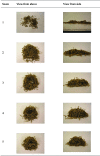Home improvement: C57BL/6J mice given more naturalistic nesting materials build better nests
- PMID: 19049249
- PMCID: PMC2687128
Home improvement: C57BL/6J mice given more naturalistic nesting materials build better nests
Abstract
Environmental enrichment of laboratory mice can improve the quality of research, but debate arises over the means of enrichment and its ability to be used in a sterile environment. One important form of enrichment is nesting material. Mice in the wild build dome-shaped, complex, multilayered nests, but this behavior is not seen in the laboratory, perhaps due to inappropriate nesting material rather than the nest-building ability of the mice. Here we focus on the use of naturalistic nesting materials to test whether they improve nest quality through the use of a 'naturalistic nest score' system; we also focus on materials that can be sterilized and easily used in existing housing systems. We first determined whether C57BL/6J mice build naturalistic nests when given shredded paper strips. We then compared these shredded paper strips with other commonly used nesting enrichments (facial tissues and compressed cotton squares). Nests were scored for 6 d. We found that the shredded paper strips allowed the mice to build higher quality nests than those built with any of the other materials. Nests built with tissues were of intermediate quality, and nests built with compressed cotton squares were of poor quality, similar to those built by the control group. These results suggest that C57BL/6J mice given appropriate nesting materials can build nests similar to those built by their wild counterparts.
Figures





Similar articles
-
Observations on the prevalence of nest-building in non-breeding TO strain mice and their use of two nesting materials.Lab Anim. 1997 Apr;31(2):125-32. doi: 10.1258/002367797780600134. Lab Anim. 1997. PMID: 9175009
-
Preferences for nesting material as environmental enrichment for laboratory mice.Lab Anim. 1997 Apr;31(2):133-43. doi: 10.1258/002367797780600152. Lab Anim. 1997. PMID: 9175010
-
Nest Building Behavior as an Early Indicator of Behavioral Deficits in Mice.J Vis Exp. 2019 Oct 19;(152). doi: 10.3791/60139. J Vis Exp. 2019. PMID: 31680688
-
Improving housing conditions for laboratory mice: a review of "environmental enrichment".Lab Anim. 2002 Jul;36(3):243-70. doi: 10.1258/002367702320162379. Lab Anim. 2002. PMID: 12144738 Review.
-
Climate change and nesting behaviour in vertebrates: a review of the ecological threats and potential for adaptive responses.Biol Rev Camb Philos Soc. 2017 Nov;92(4):1991-2002. doi: 10.1111/brv.12317. Epub 2016 Dec 16. Biol Rev Camb Philos Soc. 2017. PMID: 27982504 Review.
Cited by
-
Effects of Trio and Pair Breeding of Mice on Environmental Parameters and Nasal Pathology and Their Implications for Cage Change Frequency.J Am Assoc Lab Anim Sci. 2020 May 1;59(3):288-297. doi: 10.30802/AALAS-JAALAS-19-000074. Epub 2020 Feb 28. J Am Assoc Lab Anim Sci. 2020. PMID: 32111266 Free PMC article.
-
Early-Life Stress Paradigm Transiently Alters Maternal Behavior, Dam-Pup Interactions, and Offspring Vocalizations in Mice.Front Behav Neurosci. 2016 Jul 5;10:142. doi: 10.3389/fnbeh.2016.00142. eCollection 2016. Front Behav Neurosci. 2016. PMID: 27458353 Free PMC article.
-
Mouse Model of Parkinson's Disease with Bilateral Dorsal Striatum Lesion with 6-Hydroxydopamine Exhibits Cognitive Apathy-like Behavior.Int J Mol Sci. 2024 Jul 22;25(14):7993. doi: 10.3390/ijms25147993. Int J Mol Sci. 2024. PMID: 39063235 Free PMC article.
-
Polypharmacy With High Drug Burden Index (DBI) Alters the Gut Microbiome Overriding Aging Effects and Is Reversible With Deprescribing.J Gerontol A Biol Sci Med Sci. 2023 Feb 24;78(2):213-222. doi: 10.1093/gerona/glac195. J Gerontol A Biol Sci Med Sci. 2023. PMID: 36124741 Free PMC article.
-
Environmental enrichment during rearing alters corticosterone levels, thymocyte numbers, and aggression in female BALB/c mice.J Am Assoc Lab Anim Sci. 2012 Jan;51(1):18-24. J Am Assoc Lab Anim Sci. 2012. PMID: 22330863 Free PMC article.
References
-
- Barnard CJ, Behnke JM, Sewell J. 1996. Environmental enrichment, immunocompetence, and resistance to Babesia microti in male mice. Physiol Behav 60:1223–1231 - PubMed
-
- Baumans V. 2005. Environmental enrichment for laboratory rodents and rabbits: requirements of rodents, rabbits, and research. ILAR J 46:162–170 - PubMed
-
- Baumans V, Schlingmann F, Vonck M, Van Lith HA. 2002. Individually ventilated cages: beneficial for mice and men? Contemp Top Lab Anim Sci 41:13–19 - PubMed
-
- Bayne K. 2005. Potential for unintended consequences of environmental enrichment for laboratory animals and research results. ILAR J 46:129–139 - PubMed
-
- Belz EE, Kennell JS, Czambel RK, Rubin RT, Rhodes ME. 2003. Environmental enrichment lowers stress-responsive hormones in singly housed male and female rats. Pharmacol Biochem Behav 76:481–486 - PubMed
Publication types
MeSH terms
LinkOut - more resources
Full Text Sources
Other Literature Sources
